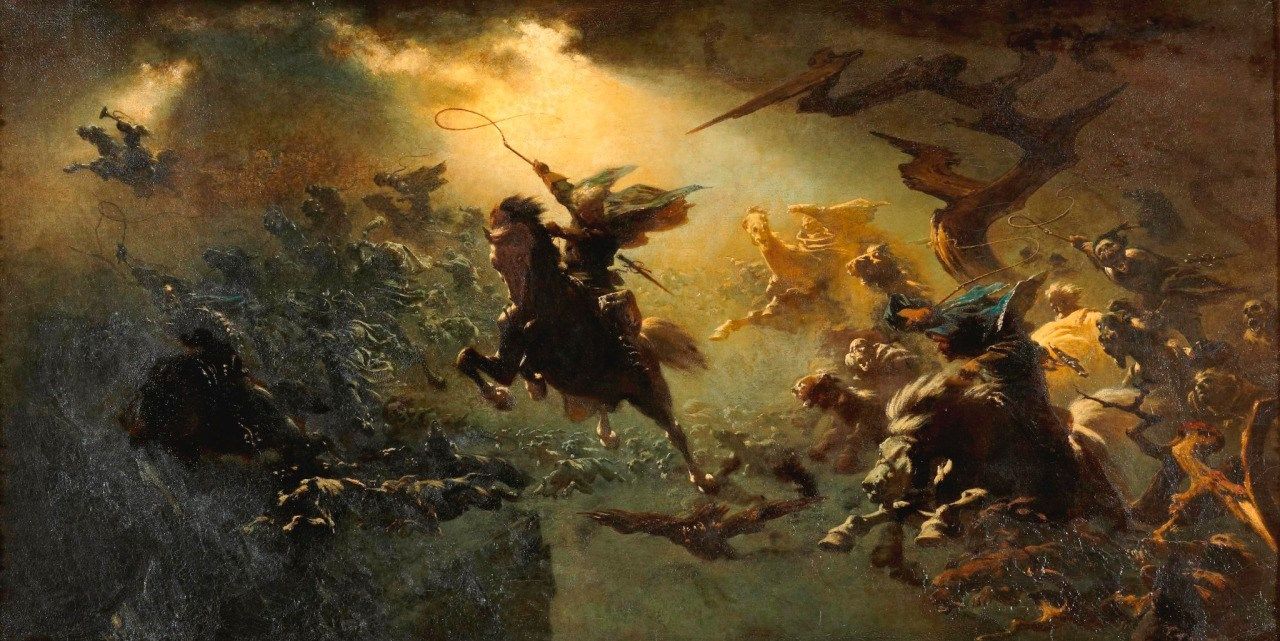The greater Heathen revival like any similar religious phenomenon, has trends, and goes through different gyrations over time as it matures, and I want to talk about one of them in this post, that I have seen gaining traction lately. Henotheism. Henotheism is a religious belief system in which an individual worships one particular god while not denying the existence or possible existence of other deities. In henotheism, devotees focus their devotion primarily on one god out of many, often considering this deity supreme in some way without rejecting the reality of others.
In contrast to:
- Monotheism, which acknowledges only one god and denies the existence of any others.
- Polytheism, which involves the worship of multiple gods, often with each deity having specific roles or domains.
In the context of our discussion, henotheism manifests when practitioners of Heathenry exclusively venerate a single deity, effectively elevating that god or goddess above the rest of the pantheon in their personal practice. This approach can lead to overlooking the distinct portfolios and roles of other deities, potentially diluting the rich diversity that characterizes polytheistic traditions like our own.
Over-Rotating on the Portfolios of the Gods
Now, it must be said that during the early years of the revival, there was indeed a tendency to pigeonhole the gods with very constrained characterizations like, “the god of war” or “the goddess of love”. Certainly, the gods are more complex than this. We see that historically, gods like Woden who is is often associated with rulership and war, is also a harvest god, as well as a god of scholarship and protection. Nehalennia is associated not only with maritime travel, but fertility, and even the dead. Still, it is not typically said that Woden is called upon to assist in childbirth, or that Éostre is often sacrificed to for victory in battle, so there is a rhyme and reason to such things. Nehalennia is a feminine divinity, associated with the water, and with liminality. This can in turn, explain many of her knock-on associations with other things. The gods are not in any sense, interchangeable.
While earlier understandings of the gods were often too simplistic—treating them as mere personifications of singular concepts like “the god of war” or “the goddess of love”—we now seem to be facing the opposite issue. Increasingly, some practitioners treat the gods as having no defined portfolios at all. Rather than being tied to specific forces or domains, the gods are now perceived as limitless and interchangeable, able to represent anything a worshiper desires. In an attempt to respect their complexity, we risk rendering the gods indistinct, transforming them into deities of everything and nothing at the same time. When the gods are treated as interchangeable entities, each capable of embodying all aspects of life, we begin to lose the value of polytheism itself. After all, if every god is a god of war, love, fertility, and wisdom, what is the purpose of having more than one deity? This is the road to the monotheism that many of our fellow Heathens were so anxious to escape! All our pre-conversion sources clearly support the idea that the gods had portfolios, or domains, even if they were sometimes broad. Yes, these domains overlap. Heliþ and Þunor can both be seen as gods of healing, but how they approach “healing” could be viewed very differently. The sacred waters of Heliþ soothe, while Þunor, the hallower and enemy of malign spirits, is invoked to drive out the spirit of disease, as seen in the “Canterbury Charm”.
There is indeed historical evidence that people in pre-Christian Germanic societies committed themselves to particular gods. The Thorsberg chape1https://en.wikipedia.org/wiki/Thorsberg_chape, found in a bog in modern-day Germany, is one of the more intriguing examples. It bears a runic inscription that translates to something along the lines of “Wolþur’s Servant, not ill-famed.” This suggests the person may have dedicated themselves, or at least the weapon, to a specific deity— Wulþ.
In Scandinavian sources, we also encounter references to individuals who were closely aligned with particular gods, such as being called “Freyr’s man.” This is evident in sagas like Hrafnkels saga Freysgoða, where the main character, Hrafnkel, dedicates himself to Freyr and builds a temple in his honor.
These historical practices provide a useful lens through which to view modern trends. It is clear that dedicating oneself to a god was meaningful, but it was not done at the exclusion of all others. This balance allowed personal devotion while maintaining the integrity of community rituals and seasonal celebrations. This context highlights the potential risks today, where an exclusive focus on one deity can unintentionally mirror monotheistic tendencies, leading to a fragmented community and a weakening of shared worship. As we see in the Baptismal Vow that was forced upon the Saxons on their defeat by Charlemagne:2https://en.wikipedia.org/wiki/Old_Saxon_Baptismal_Vow
I renounce all the words and works of the devil, Thunaer (Thor), Woden (Odin), and Saxnot, and all their companions.
This oath required converts to explicitly renounce their allegiance to multiple pagan gods, specifically naming Thunaer, Woden, and Saxnot. The convert also had to reject “all their companions,” framing these gods as demons in the Christian context.
So, while personal dedication was present historically, it was never about the exclusion of other gods from communal life or ritual. This reinforces the idea that, although individuals might align with a particular deity, this did not negate the significance of the entire pantheon. The shift we observe today, where personal preference sometimes narrows focus to a single deity in a way that diminishes others, risks fracturing communal worship practices. The Saxon oath underscores that even in the ancient world, gods were part of a larger religious system—one that required acknowledgment of many divine forces within seasonal and collective practices, not just personal devotion.
Animism and Many Immanent Gods
This erosion of the gods’ distinct roles also disrupts one of the core naturalistic aspects of Heathenry. In the past, the gods were revered as personifications of specific forces in the world—forces that exist in dynamic relation to each other, just as the gods themselves do. This natural order emphasizes the complexity of life, requiring us to honor many gods, each with their own roles in maintaining the balance of existence. The very name Þunor means “thunder”. This is not because he’s the god of sunshine!
Animism, the idea that every part of the natural world has its own soul or animating principle, is central to our practice in the Society. It teaches us that the observable universe is alive with spirits—trees, rivers, rocks, storms, all have their own essence. This doctrine reminds us that the sacred exists not only in the grand figures of gods but also in every leaf, breeze, and animal we encounter. But if we truly embrace animism, then how can we justify taking domains from various gods and handing them over to a singular favorite deity? When we address the gods in worship, the “personality” we are imagining is simply the surface layer, what we are trying to connect with, is the profound nature of what lies underneath. To fall in love with the personality of a god which may to some degree merely be a construct of our own flawed mortal intellects, while losing sight of what the god truly represents, is a disservice to the god, and the celebrant. I am aware that this notion that the gods are primarily “personalities” rather than personifications of powerful cosmic forces has been injected into the blogosphere by a certain YouTube personality and unemployed linguist (who is not a folklorist nor a Heathen) and that message has been entirely destructive and at least partially wrong. For him to imply the Norse Ægir is not a god of the sea, is about as factually incorrect as a statement can be.
Heathenship is Communal at the Core
I feel this trend also reveals a deeper issue; the growing tendency to conflate personal comfort with cosmic importance. It’s natural—and even healthy—to feel a stronger connection to one or two gods. Some practitioners may dedicate themselves in service to a particular deity, developing a relationship with them that feels especially meaningful. There is nothing wrong with these personal connections; in fact, they can be a powerful and transformative part of one’s spiritual life. The problem arises, however, when these personal preferences lead us to assume that other gods are somehow less important simply because we don’t feel the same resonance with them.
The gods do not exist solely to cater to our personal comfort or emotional needs. Each deity plays a vital role in the cosmic order, regardless of how connected or disconnected we may feel to them on a personal level. Heathenry is not about choosing a favorite god and treating them as the center of the universe—it is about engaging with the divine forces that shape the world in all their diversity. Our personal relationships with the gods are meaningful, but they do not diminish the significance of those deities with whom we feel less affinity. The implications of this trend extend beyond individual practice, posing a threat to the broader Heathen community. Heathenry, by nature, thrives on shared rituals, collective worship, and a mutual understanding of the pantheon. But when every practitioner isolates themselves with their “chosen” deity, we begin to see fragmentation. Without shared traditions and a common framework, the community risks devolving into countless personal practices—thousands of people practicing thousands of individual religions. What’s worse, such individualism risks slipping back into a framework more closely aligned with monotheism, where each person elevates their god of choice to the exclusion of all others. This is not the path to building a sustainable and resilient polytheistic tradition.
The trend of focusing exclusively on one deity or treating the gods as interchangeable also poses a threat to communal and regular seasonal worship, where the emphasis must necessarily shift from personal spirituality to collective ritual. In group settings—whether a blót or a seasonal festival—it’s not “all about you.” These ceremonies honor the cycles of nature, the gods associated with them, and the shared bonds within the community. Seasonal rituals traditionally call upon the appropriate gods for specific events, such as Frea at harvest festivals or Þunor during rites seeking protection from storms. When individual preferences dominate and gods are flattened into abstract figures without distinct roles, the coherence and intent of these shared rituals erode. This fragmentation risks turning community worship into a collection of isolated, personal devotions rather than a unified act that honors both the gods and the cycles they govern.
Conclusion
In conclusion, the trend toward personalizing Heathenry by centering devotion on a single deity—while understandable—risks undermining the core of polytheism and fracturing the communal spirit essential to our traditions. Historical practices, like the dedication of individuals to gods such as Freyr or Thor, were always balanced by the acknowledgment of other deities and their roles in seasonal and communal rites. As the Saxon baptismal oath demonstrates, pre-Christian societies maintained rich, interconnected relationships with multiple gods, not exclusive ones.
The gods are not here to serve individual needs or preferences; they embody distinct forces that shape the world, and their worship reflects the dynamic interplay of these forces. When we collapse divine roles into personal devotion or blur the lines between gods, we lose the depth and coherence that make Heathenry vibrant. To build a resilient and thriving tradition, we must honor not only our personal connections but also the full pantheon, respecting each god’s portfolio and participating in collective worship that transcends the self. The gods deserve no less—and so do we.




